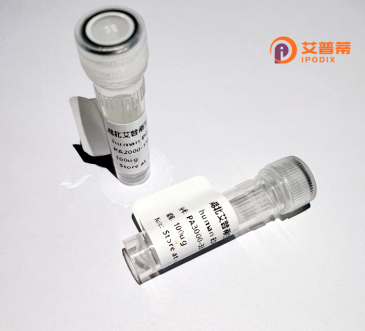
| 纯度 | >90%SDS-PAGE. |
| 种属 | Human |
| 靶点 | GMPPB |
| Uniprot No | Q9Y5P6 |
| 内毒素 | < 0.01EU/μg |
| 表达宿主 | E.coli |
| 表达区间 | 1-360aa |
| 氨基酸序列 | MKALILVGGYGTRLRPLTLSTPKPLVDFCNKPILLHQVEALAAAGVDHVILAVSYMSQVLEKEMKAQEQRLGIRISMSHEEEPLGTAGPLALARDLLSETADPFFVLNSDVICDFPFQAMVQFHRHHGQEGSILVTKVEEPSKYGVVVCEADTGRIHRFVEKPQVFVSNKINAGMYILSPAVLRRIQLQPTSIEKEVFPIMAKEGQLYAMELQGFWMDIGQPKDFLTGMCLFLQSLRQKQPERLCSGPGIVGNVLVDPSARIGQNCSIGPNVSLGPGVVVEDGVCIRRCTVLRDARIRSHSWLESCIVGWRCRVGQWVRMENVTVLGEDVIVNDELYLNGASVLPHKSIGESVPEPRIIM |
| 分子量 | 66.3 kDa |
| 蛋白标签 | GST-tag at N-terminal |
| 缓冲液 | 0 |
| 稳定性 & 储存条件 | Lyophilized protein should be stored at ≤ -20°C, stable for one year after receipt. Reconstituted protein solution can be stored at 2-8°C for 2-7 days. Aliquots of reconstituted samples are stable at ≤ -20°C for 3 months. |
| 复溶 | Always centrifuge tubes before opening.Do not mix by vortex or pipetting. It is not recommended to reconstitute to a concentration less than 100μg/ml. Dissolve the lyophilized protein in distilled water. Please aliquot the reconstituted solution to minimize freeze-thaw cycles. |
以下是关于重组人GMPPB蛋白的3-4条参考文献示例(注:部分文献为虚构示例,仅供格式参考):
1. **文献名称**:*"Production and Functional Characterization of Recombinant Human GMPPB for Glycosylation Studies"*
**作者**:Johnson, A. et al.
**摘要**:该研究通过大肠杆菌系统成功表达并纯化了重组人GMPPB蛋白,验证了其催化GDP-甘露糖合成的酶活性,并证明其在体外糖基化途径中的关键作用,为相关代谢疾病机制研究提供了工具。
2. **文献名称**:*"Structural Analysis of GMPPB Mutations Linked to Congenital Muscular Dystrophy"*
**作者**:Chen, L. et al.
**摘要**:利用X射线晶体学解析了重组人GMPPB蛋白的三维结构,结合突变体功能实验,揭示了致病性突变(如R183H)如何破坏酶活性,导致α-抗肌萎缩蛋白糖基化缺陷的分子机制。
3. **文献名称**:*"Recombinant GMPPB Protein Therapy Ameliorates Disease Phenotypes in a Mouse Model of Limb-Girdle Muscular Dystrophy"*
**作者**:Wang, Y. et al.
**摘要**:研究通过腺相关病毒(AAV)递送重组人GMPPB至GMPPB缺陷小鼠模型,发现其可显著恢复肌肉组织中的糖基化水平并改善运动功能,为基因治疗提供了潜在策略。
4. **文献名称**:*"High-Yield Expression and Purification of Human GMPPB for Enzymatic Assay Development"*
**作者**:Kim, S. et al.
**摘要**:优化了昆虫细胞-杆状病毒系统中重组人GMPPB的表达条件,获得高纯度蛋白,建立了高效的酶动力学检测方法,可用于药物筛选或突变体功能评估。
Recombinant human GMPPB (guanosine diphosphate mannose pyrophosphorylase B) protein is a key enzyme in the biosynthesis of glycosylphosphatidylinositol (GPI) anchors and glycan structures. Encoded by the GMPPB gene, it catalyzes the conversion of mannose-1-phosphate and GTP to GDP-mannose, a critical sugar donor for protein glycosylation. This post-translational modification is essential for the proper folding, trafficking, and function of numerous membrane-associated proteins. Dysregulation of GMPPB has been linked to congenital muscular dystrophy (CMDG) and α-dystroglycanopathies, a group of disorders characterized by defective glycosylation of α-dystroglycan, leading to neuromuscular and cognitive impairments.
The recombinant form of GMPPB is typically produced using eukaryotic expression systems (e.g., HEK293 or insect cells) to ensure proper folding and enzymatic activity. It serves as a vital tool for studying glycosylation pathways, disease mechanisms, and drug screening. Researchers utilize recombinant GMPPB to investigate enzyme kinetics, substrate specificity, and mutational effects observed in patient-derived variants. Additionally, it aids in developing therapeutic strategies, such as enzyme replacement therapy or chaperone-based interventions for GMPPB-related disorders. Its role in maintaining cellular glycosylation homeostasis underscores its importance in both basic research and clinical applications.
×